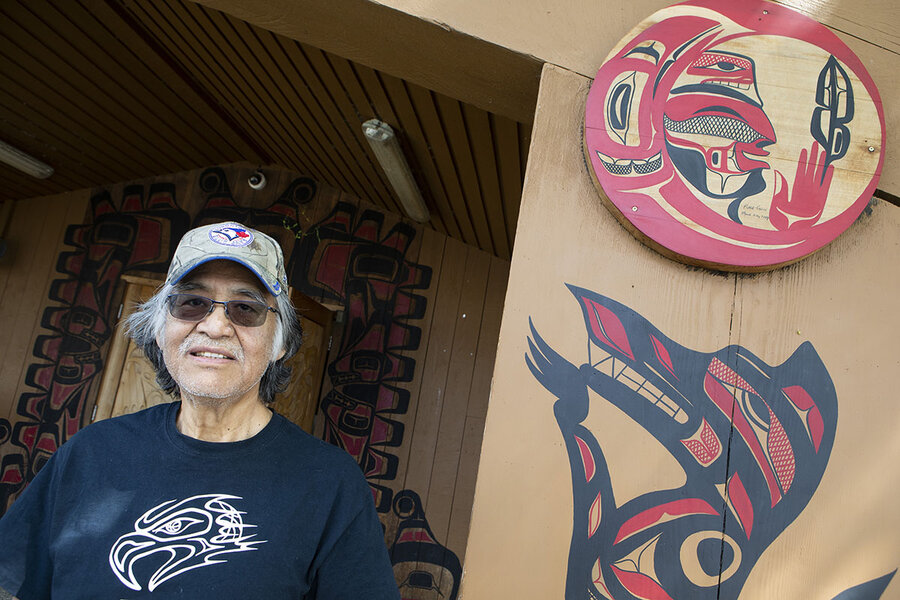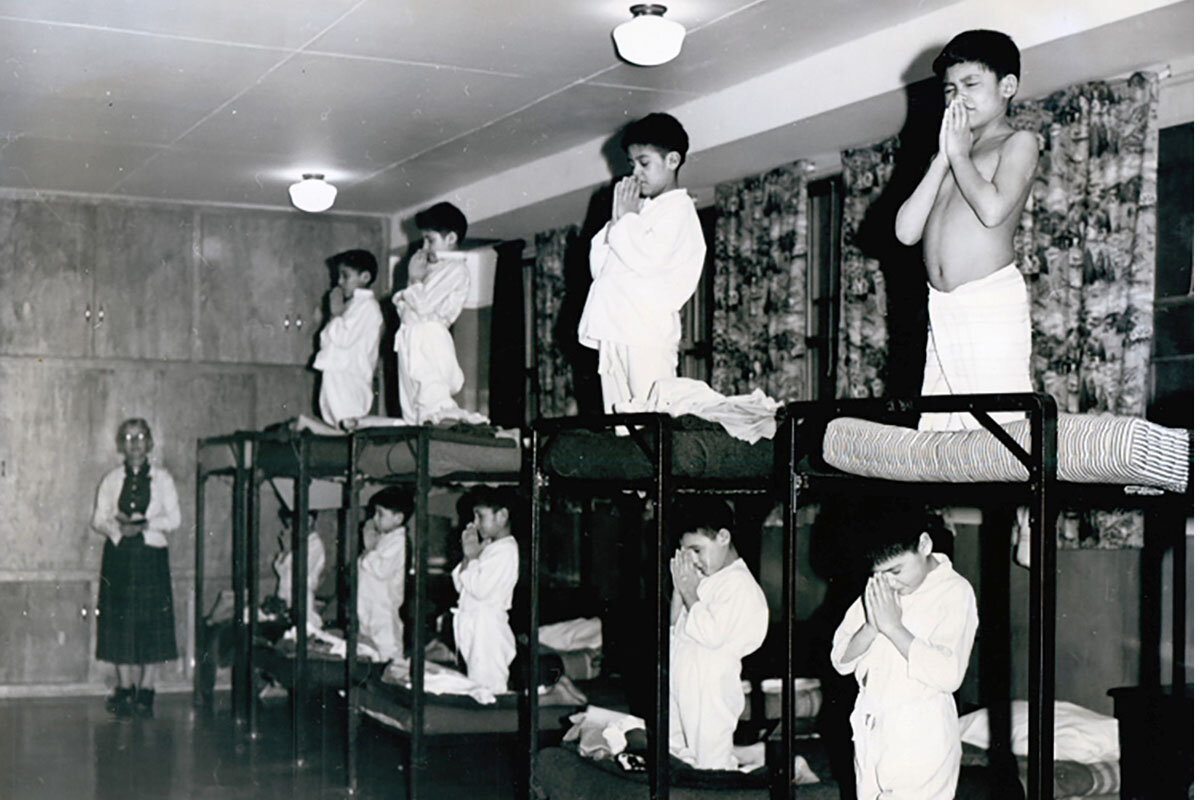‘The pope needs to apologize.’ Unmarked graves near schools roil Canada.
Loading...
| Toronto
In photos, it appears to be just any grassy field. But under the earth of the First Nation reserve in Saskatchewan are the plotted yet unmarked graves of an estimated 751 people, many of them children. And Indigenous leaders are demanding an apology from the Roman Catholic Church for it.
The remains were found near the former Catholic-run Marieval Indian Residential School, one of scores of government-sponsored religious institutions that forcibly removed Indigenous children from their homes to deal with what was once called the “Indian problem.”
Cadmus Delorme, the chief of the Cowessess First Nation, said at a press conference Thursday that they believe headstones were removed by a Catholic representative in the 1960s, which turns the field essentially into a “crime scene,” he said. “The pope needs to apologize.”
Why We Wrote This
As pressure builds for a papal apology over treatment of Indigenous children in Catholic-run residential schools, some survivors say the deep concern is to be heard – that the world “believes what was done to us.”
For over a century, an estimated 130 residential schools across Canada were operated by a variety of Christian denominations, but the Catholic Church was responsible for about two-thirds of them. And unlike the Protestant denominations, the Roman Catholic Church is the only one not to have issued a formal apology.
As Canadian anguish over the findings continues to mount, many here hope that the Catholic Church forges a more cooperative approach to addressing its role in subjugating Indigenous peoples. This discovery follows one last month of 215 children found near a Catholic-run residential school in Kamloops, British Columbia – putting pressure on Pope Francis to issue an apology and for local Catholic leaders to release all records that are available, says Kathleen Mahoney, an expert in reparations for mass human rights abuses at the University of Calgary.
“If they are burying children in this way, not only is this a profound human rights abuse and moral question, it’s a legal question,” says Ms. Mahoney, the chief negotiator for the Assembly of First Nations during Indian residential school settlement talks. “This has become basically an existential issue, because I think now most Canadians are saying, ‘What is going on? Who are we?’ … There’s a point at which the church can no longer remain silent on this.”
The news has resonated globally. This week U.S. Interior Secretary Deb Haaland, the first Native American cabinet member, said the government would investigate its own legacy of boarding schools for Native Americans, including possible burial sites.
In a letter to Chief Delorme on Thursday, Archbishop Don Bolen of Regina, Saskatchewan’s capital, apologized for the “failures and sins of Church leaders and staff” and pledged to help identify the remains. “The incredible burden of the past is still with us, and the truth of that past needs to come out, however painful,” he wrote.
The letter also acknowledged their claim that headstones may have intentionally been removed by a priest.
Earlier, the Canadian Conference of Catholic Bishops expressed the “deepest sorrow for the heartrending loss of the children at the former Kamloops Indian Residential School on the Tk’emlúps te Secwépemc First Nation.”
But many want a formal apology from Pope Francis, who declined to do so after being pressed by Canadian Prime Minister Justin Trudeau, a Catholic, earlier this month. Instead he acknowledged the “pain” of the discovery in British Columbia.
The existence of remains has been known to Canadian society at large since at least 2015, when the Truth and Reconciliation Commission (TRC) concluded that Canada committed “cultural genocide” in removing 150,000 Indigenous children from their homes. An estimated 4,100 children died.
But Angela White, executive director of the Indian Residential School Survivors Society in British Columbia, says the discovery of unmarked graves has put the reality into sharp focus for Canadians.
“When you actually had [survivors] testifying at the TRC, you’re looking at the faces of those who are now 30, 40, 50, 60, 70 years of age,” she says, and people may not “comprehend that the stories they’re sharing were the memories of a child,” she says.
The government of Canada formally apologized to survivors in 2008. One of the Calls to Action from the TRC is an apology from the Catholic Church.
The recent findings have renewed pressure on the Vatican, from petitions among Catholic laypeople demanding a papal apology to health care workers asking Canadian bishops to invite Pope Francis to visit the nation and “make a public apology on behalf of the Church in Canada for our sins of commission and omission in the matter of Residential Schools.”
The controversy over a papal apology has rankled some Catholic representatives in Canada. One pastor in the Archdiocese of Kingston, Ontario, wrote in Canada’s Catholic Register that it obscures the reconciliation that has taken place between Rome and Indigenous leaders in Canada.
A priest in Mississauga, outside Toronto, came under fire for defending the “good done” by the Catholic Church in its residential schools in a sermon last Sunday.
The Rev. Michael Coren, an Anglican priest and author, has criticized the Roman Catholic Church for not apologizing, out of fear of financial repercussions and for ideology. “They’re very nervous about deconstructing the whole history of evangelism, and evangelism and colonization often went hand in hand,” says Mr. Coren. “It’s those two aspects: one purely selfish monetary and the other one philosophical and ideological.”
Ms. Mahoney says that even if there are legal implications for the allegations around unmarked graves at Catholic-run schools across Canada, in her work both in Northern Ireland (with child abuse victims in residential institutions) and with Indigenous residential school survivors, it is not reparations that survivors most seek.
“Their first desire is to tell their story and be believed ... to find out what happened to their loved ones,” she says. “The Catholic Church, for one thing, should make available all the records that they have. They haven’t done that so far.”
Wally Samuel, who lives in Port Alberni in British Columbia and attended the former residential school in that city for seven years, says the most important part for him is the acknowledgment of the atrocity of forced assimilation that is now top of mind for non-Indigenous society.
“Hopefully now the world believes our stories, believes what was done to us,” says Mr. Samuel in a phone interview. “The hardest part was trying to force Christianity on you, making you try to change and do what they believe. We kept being told we’re no good, that our languages and cultures are wrong.”
“A lot of our friends and family still practice Christianity. We don’t bother them about it. You have to respect everyone’s beliefs and religions. ... It’s important for the survivors that the church apologizes for what it did.”








